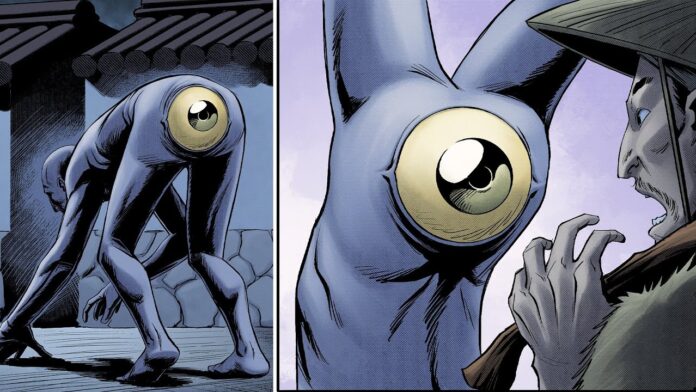The Japanese folklore’s most cheeky spirit
Regarding Japanese folklore, few creatures are as bizarre or oddly charming as the Shirime. This peculiar yokai (a class of supernatural beings and spirits in Japanese tradition) is remembered not for fearsome powers or tragic backstories, but for one simple, surreal anatomical oddity: it has a large, glowing eye where its anus should be. The very name “Shirime” translates directly to “butt eye” or “rear-end eye,” leaving no doubt about the creature’s most distinctive feature.
A moonlit encounter with the strange
The legend of the Shirime dates back to the Edo period and is most famously reported by the renowned poet and painter Yosa Buson (1716-1784). In the tale, a lone samurai walks the road to Kyoto at night when a mysterious man calls out to him, asking for a moment of his time. As the samurai turns to face him, the stranger suddenly bends over, drops his kimono, and spreads his buttocks wide—revealing a single, large shining eye where his anus should be, staring directly at the horrified samurai. Shocked and terrified by this posterior peeper, the samurai flees into the night.
Unlike many yokai that actively harm humans, the Shirime isn’t known to curse or injure people. Its goal seems purely to startle and discomfort—and perhaps amuse. It’s a spirit of surprise rather than malice, embodying the unexpected encounters that might befall travelers on lonely roads after dark.
Meaning beneath the madness
Though it might sound like nothing more than a crude anatomical joke, the Shirime can also be interpreted as a form of cultural satire. During the Edo period (1603–1868), Japanese artists and writers often used yokai to reflect societal tensions, anxieties, or even to challenge norms through absurdity. The Shirime, with its posterior-positioned eye, may have been a humorous jab at samurai stoicism or a manifestation of the fears associated with travel during pre-modern times when roads were dangerous and encounters with strangers potentially threatening.
The creature’s defining feature—an eye where an anus should be—also connects to broader themes in yokai lore about bodily transformation and the uncanny. Many Japanese spirits feature displaced body parts or physical anomalies that challenge our understanding of what bodies should look like, though few are quite as cheeky as the Shirime’s rear-viewing eyeball.
Shirime in pop culture
While not as internationally recognized as yokai like the Kappa or Kitsune, the Shirime has maintained a presence in modern Japanese media. It appears in encyclopedias of yokai, manga anthologies, and occasionally in anime series that feature traditional folklore elements. It has been included in Shigeru Mizuki’s influential yokai works and in museums dedicated to Japanese supernatural folklore, usually depicted with a blend of horror and humor that stays true to its origins.
The Shirime also perfectly exemplifies the bakemono (monster) tradition that influenced later Japanese horror aesthetics, where the uncanny and the absurd often intertwine.
Why we still talk about shirime
In the vast pantheon of yokai, the Shirime stands out as a reminder of Japanese folklore’s creative diversity. It blends the eerie with the comedic and the traditional with the unexpected. Unlike many mythological creatures that evoke fear or reverence, the Shirime—with its unforgettable anal eye—invites us to laugh, to be surprised, and to recognize that even folklore has room for the delightfully weird and anatomically impossible.
The Shirime also serves as an excellent entry point into understanding how yokai stories function in Japanese culture, not simply as scary stories, but as complex cultural expressions that can range from terrifying to comical, often serving as commentary on human behavior or social conditions. The bottom-based eyeball of the Shirime certainly captures attention in a way few other folkloric elements can.
Whether you see it as a symbol of humor, an artistic oddity, or simply a good story to tell on a spooky night, the Shirime has earned its place as one of Japan’s most unforgettable yokai, proving that sometimes the most memorable monsters are the ones that catch us completely off-guard.

